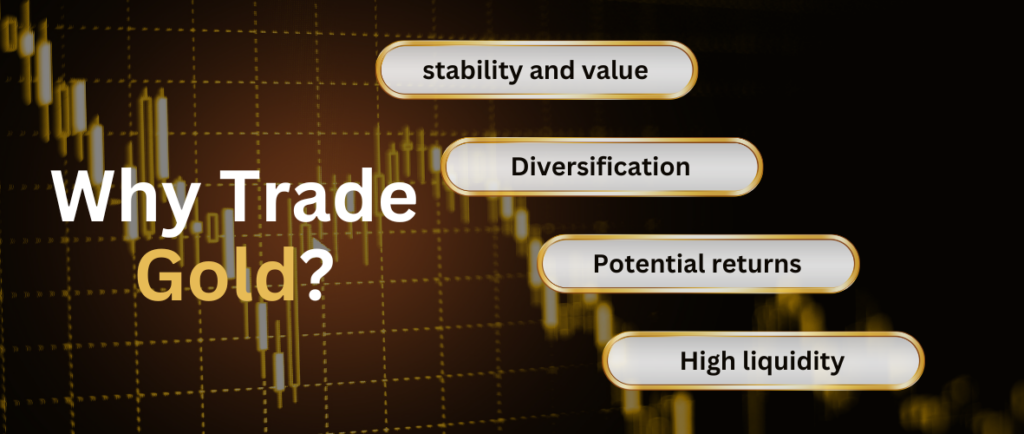Often referred to as a “safe haven,” gold has consistently held its value during unpredictable market conditions. Its ability to act as a hedge against economic risks makes it highly sought after as well. Although gold is a commonplace item, beginners may find the idea of gold trading intimidating.
We’ll cover all you need to know about gold trading in this article, giving you all you need to start trading gold as a beginner
What Does Gold Trading Mean?
The act of purchasing and selling gold with the intention of profiting from price fluctuations is known as gold trading.
There are many ways to trade gold, such as through exchange-traded funds (ETFs) or contracts for differences (CFDs). Without having to own the underlying product, traders can take advantage of trading possibilities from changes in the price of gold by using CFDs.
Only the price movement between the trade’s entry and departure points is taken into consideration when valuing a CFD. Trading long (if you think the price will rise) or short (if you think the price will decrease) is possible with CFDs.
Why Should You Start Gold Trading?

When looking into gold trading you might ask yourself why should I trade gold? The following are some reasons that make gold trading appealing as it is:
Gold Trading offers stability and value
Gold has maintained worth for centuries and often acts as a safe harbor in uncertain economic times, unlike currencies affected by policies and inflation. This dependability provides beginners with a sense of security when venturing into trading markets.
Potential returns through leverage
Many brokerages allow controlling large gold positions with low capital through contracts for difference (CFDs) and margin trading. However, leverage also magnifies gains and losses, so novices must understand risks before employing high margins.
Portfolio diversification
Including gold provides beginners a means to diversify across asset classes like equities, bonds, and commodities reacting differently to events. Spreading risk this way can offset potential losses in one area with gains elsewhere.
High market liquidity
Gold ranks among the most fluidly traded assets as buying and selling easily occurs with many counterparties available. Options like exchange-traded funds (ETFs), CFDs, options and futures contracts afford effortless entrance and exit from positions. This versatility reduces new traders becoming trapped in unfavorable trades and permits flexibly adding or removing gold to portfolios.
In a nutshell, gold is a good place to start because of its historical stability, capacity for leverage when used carefully, ability to contribute to a diversified approach, and high liquidity. Naturally, there is danger in every market, so newcomers should do a lot of study before investing. However, gold can lay the groundwork for understanding both technical and fundamental trading methods.
How Is The Gold Market Operated?
The gold market is an exchange where gold is bought and sold. It consists of a wide range of buyers and sellers, from large corporations to the average person wishing to purchase this valuable metal. There are several ways to exchange gold, including physical locations, internet marketplaces, and specialized markets.
In a model based on supply and demand, the price of gold varies according to the quantity available and the demand for buying. These variations may be caused by big world events or changes to monetary systems. The price is usually expressed in US dollars and is subject to vary based on changes in the value of the currency.
The major players in the gold market are also central banks, which are organizations that provide banking and financial services to governments. They trade gold to support the monetary policies of their respective nations. Furthermore, gold is used in many different businesses, such as the jewelry industry. These components work together to drive the gold market.
How To Trade Gold
Charts are used to illustrate the price performance of gold products and provide insights into how they vary over time. The horizontal axis of these charts can indicate a variety of time periods, such as minutes, days, weeks, months, or years, while the vertical axis shows the price of the related gold product.
For beginners, analyzing the fluctuations in gold product prices throughout the chosen period offers insight into its historical performance. Gaining proficiency in chart reading will enable novices to spot potential trends or patterns for upcoming trades. Here is a picture of a gold trading chart on the Allpips trading platform:

Deciding How To Trade Gold
Those new to gold markets have several options to explore. The purest method involves physical bullion trading. Alternatively, beginners can evaluate derivative instruments like contracts for difference (CFDs), futures contracts, and options.
With Allpips, starters gain access to gold trading through a range of selections. Users follow gold exchange-traded fund (ETF) price movements through CFDs. Charts present the live gold spot versus the U.S. dollar rate (XAU/USD) for direct exposure.
It’s important to note these derivatives are based not on ownership but on value differences between opening and closing prices. This allows taking long positions by predicting higher prices or short positions anticipating declines to profit from all market conditions.
Trading gold CFDs also permits using leverage multipliers to magnify exposure to price fluctuations. However, leveraged speculation inherently contains sizable risk and lacks suitability for long-term positions prone to abrupt downturns producing severe losses.
Allpips platforms supply beginners with opportunities to evaluate gold markets without immediate bullion ownership. Through selective CFDs or spot rates, novices gain practical knowledge of fundamental and technical analysis mechanics in navigating fluctuating gold values over time.
Beginner Tips For Trading Gold

Here are some tips for beginners starting in gold trading:
- Select a Broker. Choose a trustworthy brokerage that enables trading in gold, either through futures contracts or CFDs. Choose one that provides a beginner-friendly platform, high-quality educational resources, and low commissions.
- Start Small. When you first start trading gold, only allocate a modest amount of your entire portfolio—roughly 1% to 2%. By doing this, you can reduce risks as you build experience. Don’t risk any money by practicing with demo accounts.
- Be Cautious When Using Leverage. Leverage can increase returns, but it can also increase losses from bad deals. Leverage should be limited by new traders until they are comfortable with gold volatility.
- Keep an eye on Economic Factors. Keep an eye on how gold is affected by interest rates, inflation rates, currency values, and economic factors. When rates are lower or the dollar is weaker, the metal typically increases; when data strengthens, it usually falls.
- Pay Attention to Chart Signals. Learn to read technical indicators and patterns on gold charts to find support/resistance levels and potential reversal signals. Moving averages help identify trends.
- Diversify beyond Spot Price. Consider trading related assets like miner stocks and ETFs to balance portfolio exposures beyond just the spot rate. This adds diversification.
- Set Risk Controls. Have a maximum loss amount per trade and don’t over-trade in attempts to recoup losses. Cut losses quickly on underperforming trades rather than holding out for hoped-for reversals.
- Create a Trading Plan. New traders should devise a focused strategy testing different timeframes and methods to see what works best before risking more capital. Review each trade promptly.
- Take Profits Quickly on Winners. Lock in profits from winning gold positions rather than getting greedy and watching gains evaporate if momentum shifts against the position.
- Be Patient and Manage Emotions. Learning gold markets requires experiencing varying conditions without rash reactions. Accept early setbacks as tuition costs and avoid revenge trading after losses.
Conclusion
For beginners, gold trading offers both chances and risks. Gold is a commodity that has historically held its value, particularly in times of political and economic unpredictability. This means that its fluctuations can be taken advantage of through a variety of trading instruments. Newcomers, however, need to enter the gold markets with caution, control their risks, and be willing to learn. Over time, new traders can safely gain experience by starting small, diversifying their exposures, paying attention to economic drivers and chart indications, managing leverage, and controlling their emotions. Gold is a viable entrance point into active trading markets when used carefully and in accordance with best procedures.



